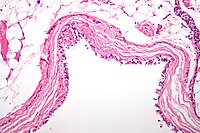
Photo from wikipedia
Objectives Aneurysmal bone cyst (ABC) and telangiectatic osteosarcoma (TOS) share several clinical and imaging features, including young presentation, long bone involvement, lytic appearance on radiography and fluid-fluid levels on MRI.… Click to show full abstract
Objectives Aneurysmal bone cyst (ABC) and telangiectatic osteosarcoma (TOS) share several clinical and imaging features, including young presentation, long bone involvement, lytic appearance on radiography and fluid-fluid levels on MRI. Therefore, they may be difficult to differentiate. The aim of this study is to identify clinical, radiological and MRI features which aid differentiation of the two lesions. Materials and methods Retrospective review of all histologically confirmed ABC and TOS over an 11-year period. Data recorded include age at presentation, sex, skeletal location and various radiographic and MRI features. Results This retrospective study included 183 patients, 92 males and 91 females. Mean age at presentation of 18.4 years (range 1–70 years); 152 cases of ABC and 31 TOS. No significant difference between age and sex. TOS was significantly less likely to involve the axial skeleton; no difference related to location within the bone. Radiographic findings significantly favouring ABC included a less aggressive pattern of bone destruction, a purely lytic appearance, an expanded but intact cortex, no periosteal response and no soft tissue mass. MRI features significantly favouring ABC included smaller tumour size (maximum mean dimension 46 mm compared to 95 mm for TOS), absence of soft tissue mass, > 2/3 of the lesion filled with fluid levels and thin septal enhancement following contrast. Conclusions Several radiographic and MRI features aid in the differentiation between ABC and TOS. Lesions with a geographic Type 1A or IB pattern of bone destruction which are completely filled with FFLs on MRI can confidently be diagnosed as ABC.
Journal Title: Skeletal Radiology
Year Published: 2020
Link to full text (if available)
Share on Social Media: Sign Up to like & get
recommendations!